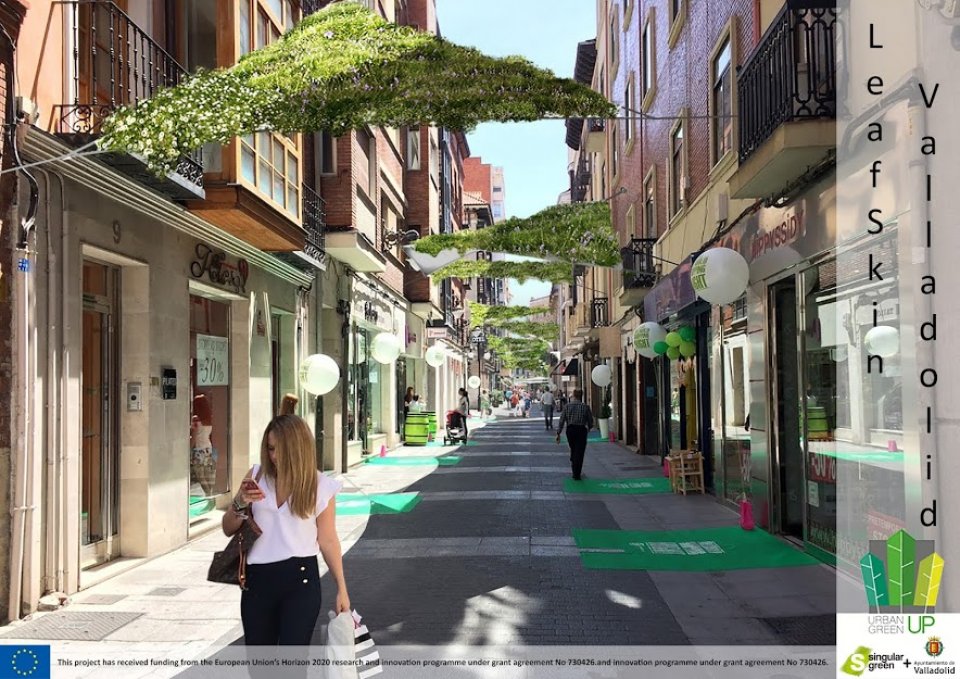
- Scale of the project: neighbourhood
- Scales impacts from this NbS action should be assessed: 1) object (building, etc.), 2) neighbourhood
- Urban density in which the NbS is implemented: high (dense city center, etc.)
The ultralight green roof structure LEAFSKYN® could be set up on any pedestrian street or square, this structure is particularly suitable for use in high urban density areas.
The system is implemented in the spanish city of Valladolid (calle Zuñiga and calle Sta. Maria) on downtone along 390m of pedestrian street. Both streets are finished in squares where there are not-used kiosks that there will be used as a room for irrigation facilities, grabbing the current misused public infrastructure.
Also these streerts, as well as the neighbourhood, contain various shoops, markets and restaurants.
LEAFSKIN® is an ultralight green roof set up over pedestrian streets or squares, in order to create shadow areas in urban spaces.
The tecnhology can also provide interesting implimentation like carring lighting system or advertising on the bottum.
Description of the NbS
The NbS is composed by three main elements:
- The facilities room. It is an unused newspaper kiosk, where there will be installed the irrigation system machines. An irrigation pipe is coming from this kiosk to the structures and a duct with the excess water returns back to it.
- Aluminium truss. Along this truss we will install the water pipes and an electric cable. Each green shady textile structure has two pipes that connect with the main one in the truss.
- It is a PVC textile strucure with triangular shape, stretched between the frontage of buildings, from 5 to 7 meters above the street, on which grows a thin layer of vegetation. On this textile structure an inert substrate is installed, then the inert substrate is covered with seeds that germinate and grow on the structure.
- reduce local temperatures in summer,
- catch and process air pollutants,
- acts as a noise shield,
- increase commercial activity as well as well-being,
- Increase real estate values.
- Developing climate change adaptation; improving risk management and resilience
- Increase infiltration / Water storage
- Reduce drought risk
- Reducing temperature at meso or micro scale
- Developing climate change mitigation
- Carbon sequestration and storage
- Restoring ecosystems and their functions
- Increase quality and quantity of green and blue infrastructures
- Changing image of the urban environment
- Improve air quality
- Improve water quality
- Increase amount of green open spaces for residents
- Increase social interaction
- Increase well-being
- Reducing wind speed
This NbS can be replicated in many different parts of the city, under various governance models:
- Implementation and maintenance by the municipality.
- Implementation and maintenance by private proprietors (street commerce or resident). No publicity.
- Implementation by the municipality and private maintenance (managed by street commerce or people who live in the street).
The solution allows to place advertising on the bottom of the infrastructure as an additional financial support. Which means the implementation and maintenance costs could be covered partially or totally.
Requirements:
- In any cases, permit are needed to be anchored to facades or install fixing posts.
- The green shady structures must comply with the following regulations:
- Orden VIV/561/2010, 1st of February, basic conditions of accessibility and non-discrimination for the access and use of urbanized public spaces
- Technical Building Code DB-SI, section 5
- Article 364 of the POGU of Valladolid, about Accessibility in emergencies
- List and Spanish catalogue of invasive alien species.
- City regulation service of water supply and sanitation.
BUSINESS MODEL:
Business cluster: Technological
Business model: Substitute with renewables and natural processes
Business cluster: Organizational
Business model: Re-purpose the business for society/environment
Product offered in the market.
Temporal perspective
Expected time for the NbS to become fully effective after its implementation: short (immediately to few months)
Feedback: not conserned
Expected life time of the intervention: around 10 years
Dates (for project delivered): 30/12/2018
The process benefit from knowledge from Singular Green company and its LEAFSKIN® technology. This new system developped can be installed in awnings or other surfaces with very low thickness.
Process enablers:
Governance drivers → Process efficiencies → Collaboration
Economy drivers → Conditions for new business models and finance schemes
Governance drivers → Process efficiencies → Capacity building
A great list of possible recommendations to be applied. Municipality, local commerce and citizens.
Process inhibitors:
Knowledge barriers → Uncertainty → Performance unknow
To be known.
Global (estimated) cost of the project: 50k€ - 200k€
Financing mechanism Cluster: cluster1 public financing
Financing model: Horizon2020
URBAN GreenUP Project (H2020 730426)
- Extensives green roofs
- Green roofs
- On building structures
- Objects Shapes
Jordi , Serramia Ruiz (jordi@singulargreen.com)
Further information
LEAFSKIN® is part of the Urban_GreenUp's NbS database.
Urban_GreenUp project has received funding from the European Union’s Horizon 2020 research and innovation program under grant agreement No 730426.
Deliverable with the NbS description : D2.3 - Technical specifications of Valladolid demo (https://www.urbangreenup.eu/insights/reports/all-deliverables.kl).
Nature4Cities (https://www.nature4cities.eu/) aims to develop a knowledge diffusion around Nature-Based Solution (NbS) and a decision support platform through new collaborative models.
LEAFSKIN® is part of the Nature4Cities's pioneer case studies database, it will feed the observatory, NbS pre-selection and replication tools, gathered into the Geocluster4NBS.
LEAFSKIN® was chosen as a pioneer case study for the following reasons: 1) Design. 2) Techniques employed. The project develop a new system that can be installed in awnings or other surfaces with very low thickness.
Nature4Cities project has received funding from the European Union’s Horizon 2020 research and innovation program under grant agreement No 730468.

